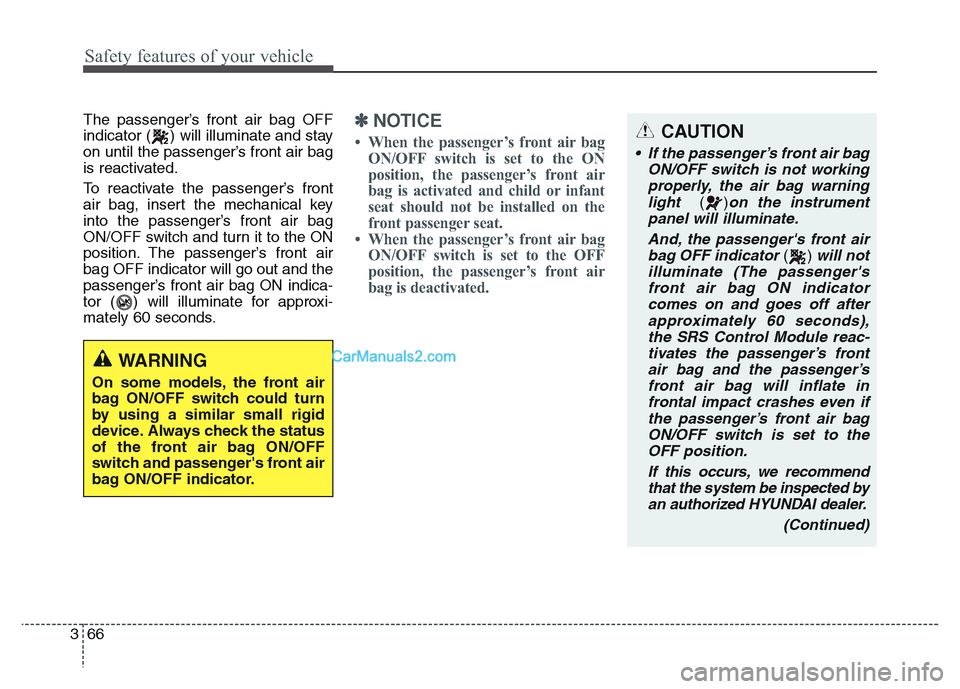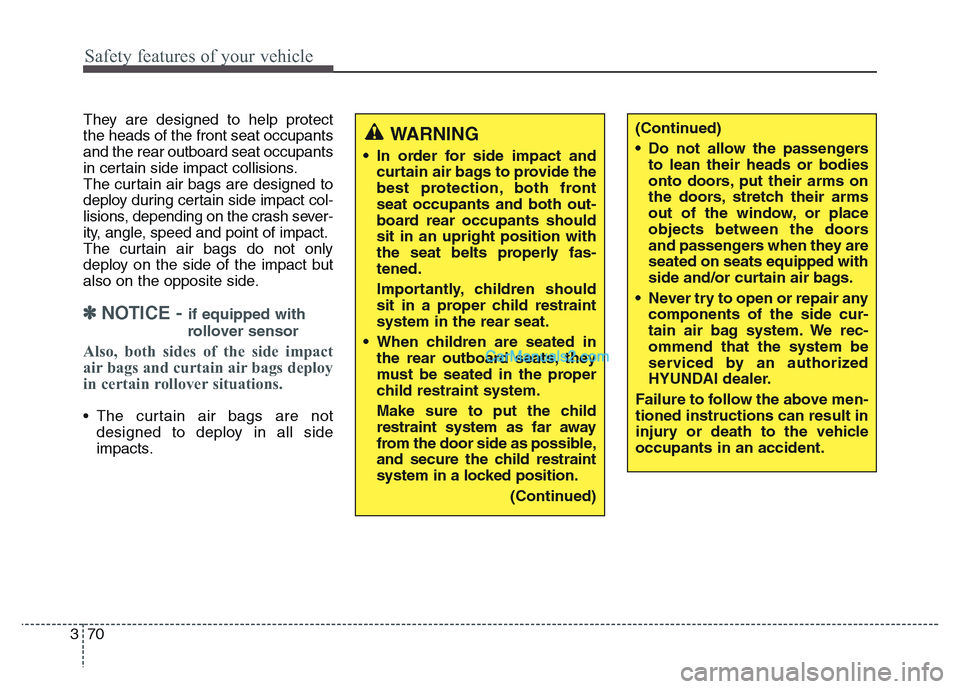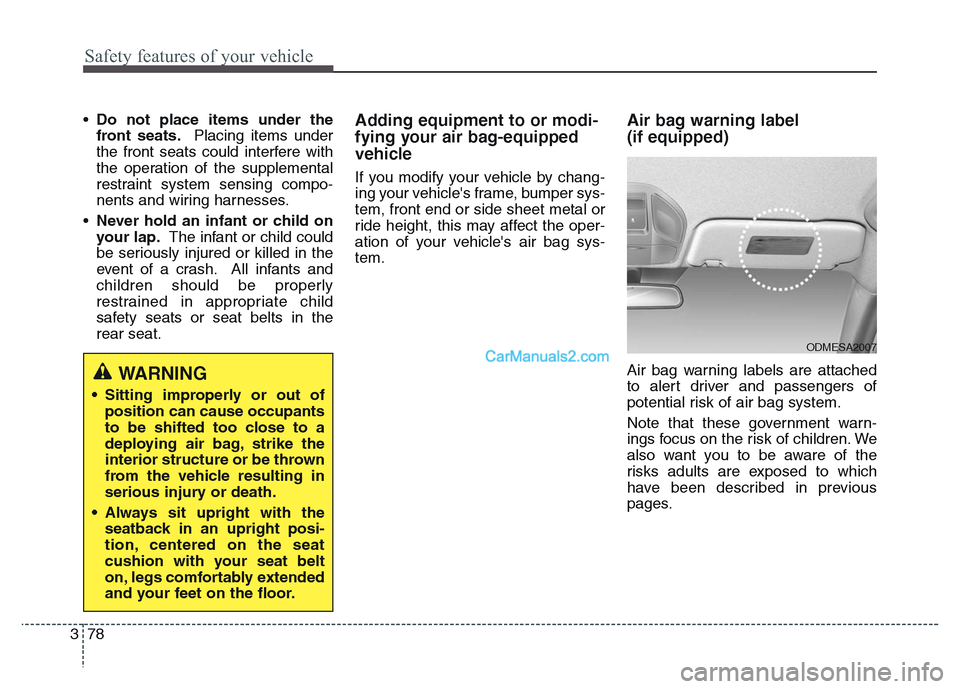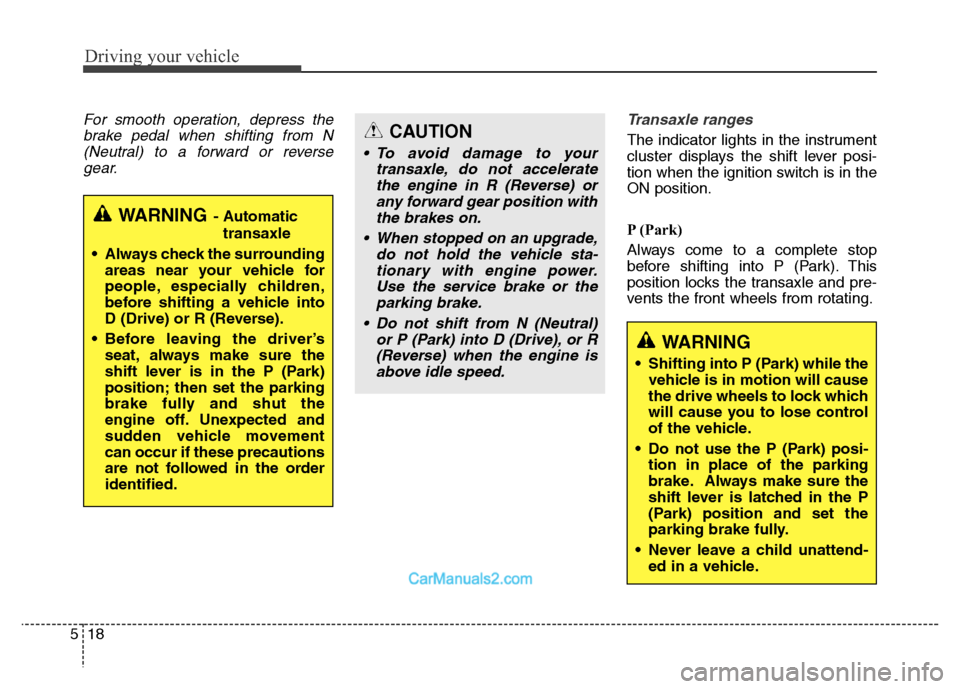Page 85 of 717

Safety features of your vehicle
66 3
The passenger’s front air bag OFF
indicator ( ) will illuminate and stay
on until the passenger’s front air bag
is reactivated.
To reactivate the passenger’s front
air bag, insert the mechanical key
into the passenger’s front air bag
ON/OFF switch and turn it to the ON
position. The passenger’s front air
bag OFF indicator will go out and the
passenger’s front air bag ON indica-
tor ( ) will illuminate for approxi-
mately 60 seconds.✽NOTICE
• When the passenger’s front air bag
ON/OFF switch is set to the ON
position, the passenger’s front air
bag is activated and child or infant
seat should not be installed on the
front passenger seat.
• When the passenger’s front air bag
ON/OFF switch is set to the OFF
position, the passenger’s front air
bag is deactivated.
WARNING
On some models, the front air
bag ON/OFF switch could turn
by using a similar small rigid
device. Always check the status
of the front air bag ON/OFF
switch and passenger's front air
bag ON/OFF indicator.
CAUTION
• If the passenger’s front air bag
ON/OFF switch is not working
properly, the air bag warning
light
()on the instrument
panel will illuminate.
And, the passenger's front air
bag OFF indicator
() will not
illuminate (The passenger's
front air bag ON indicator
comes on and goes off after
approximately 60 seconds),
the SRS Control Module reac-
tivates the passenger’s front
air bag and the passenger’s
front air bag will inflate in
frontal impact crashes even if
the passenger’s front air bag
ON/OFF switch is set to the
OFF position.
If this occurs, we recommend
that the system be inspected by
an authorized HYUNDAI dealer.
(Continued)
Page 86 of 717

367
Safety features of your vehicle
(Continued)
• If the SRS air bag warning
light blinks or does not illumi-
nate when the ignition switch
is turned to the ON position,
or if it illuminates while the
vehicle is being driven, we
recommend that the system
be inspected by an authorized
HYUNDAI dealer.(Continued)
• Even though your vehicle is
equipped with the passen-
ger's front air bag ON/OFF
switch, do not install a child
restraint system in the front
passenger's seat. A child
restraint system must never
be placed in the front seat.
Children who are too large for
child restraint systems
should always occupy the
rear seat and use the available
lap/shoulder belts. Children
are afforded the most safety
in the event of an accident
when they are restrained by a
proper restraint system in the
rear seat.
• As soon as the child seat is
no longer needed on the front
passenger's seat, reactivate
the front passenger's air bag.WARNING
• The driver is responsible for
the proper position of the pas-
senger’s front air bag ON/OFF
switch.
• Deactivate the passenger's
front air bag only when the
ignition switch is switched off,
or the malfunction may occur
in the SRS Control Module.
And there may be a danger
that the driver's and/or front
passenger’s and/or side and
curtain air bag may fail to trig-
ger, or not trigger correctly
during a collision.
• Never install a rearward fac-
ing child seat on the front pas-
senger's seat unless the pas-
senger's front air bag has
been deactivated. The infant
or child could be severely
injured or killed by an air bag
deployment in case of an acci-
dent.
(Continued)
Page 89 of 717

Safety features of your vehicle
70 3
They are designed to help protect
the heads of the front seat occupants
and the rear outboard seat occupants
in certain side impact collisions.
The curtain air bags are designed to
deploy during certain side impact col-
lisions, depending on the crash sever-
ity, angle, speed and point of impact.
The curtain air bags do not only
deploy on the side of the impact but
also on the opposite side.
✽NOTICE - if equipped with
rollover sensor
Also, both sides of the side impact
air bags and curtain air bags deploy
in certain rollover situations.
• The curtain air bags are not
designed to deploy in all side
impacts.
(Continued)
• Do not allow the passengers
to lean their heads or bodies
onto doors, put their arms on
the doors, stretch their arms
out of the window, or place
objects between the doors
and passengers when they are
seated on seats equipped with
side and/or curtain air bags.
• Never try to open or repair any
components of the side cur-
tain air bag system. We rec-
ommend that the system be
serviced by an authorized
HYUNDAI dealer.
Failure to follow the above men-
tioned instructions can result in
injury or death to the vehicle
occupants in an accident.WARNING
• In order for side impact and
curtain air bags to provide the
best protection, both front
seat occupants and both out-
board rear occupants should
sit in an upright position with
the seat belts properly fas-
tened.
Importantly, children should
sit in a proper child restraint
system in the rear seat.
• When children are seated in
the rear outboard seats, they
must be seated in the proper
child restraint system.
Make sure to put the child
restraint system as far away
from the door side as possible,
and secure the child restraint
system in a locked position.
(Continued)
Page 97 of 717

Safety features of your vehicle
78 3
•Do not place items under the
front seats.Placing items under
the front seats could interfere with
the operation of the supplemental
restraint system sensing compo-
nents and wiring harnesses.
•Never hold an infant or child on
your lap.The infant or child could
be seriously injured or killed in the
event of a crash. All infants and
children should be properly
restrained in appropriate child
safety seats or seat belts in the
rear seat.Adding equipment to or modi-
fying your air bag-equipped
vehicle
If you modify your vehicle by chang-
ing your vehicle's frame, bumper sys-
tem, front end or side sheet metal or
ride height, this may affect the oper-
ation of your vehicle's air bag sys-
tem.
Air bag warning label
(if equipped)
Air bag warning labels are attached
to alert driver and passengers of
potential risk of air bag system.
Note that these government warn-
ings focus on the risk of children. We
also want you to be aware of the
risks adults are exposed to which
have been described in previous
pages.WARNING
• Sitting improperly or out of
position can cause occupants
to be shifted too close to a
deploying air bag, strike the
interior structure or be thrown
from the vehicle resulting in
serious injury or death.
• Always sit upright with the
seatback in an upright posi-
tion, centered on the seat
cushion with your seat belt
on, legs comfortably extended
and your feet on the floor.
ODMESA2007
Page 467 of 717

Driving your vehicle
18 5
For smooth operation, depress the
brake pedal when shifting from N
(Neutral) to a forward or reverse
gear.Transaxle ranges
The indicator lights in the instrument
cluster displays the shift lever posi-
tion when the ignition switch is in the
ON position.
P (Park)
Always come to a complete stop
before shifting into P (Park). This
position locks the transaxle and pre-
vents the front wheels from rotating.
WARNING- Automatic
transaxle
• Always check the surrounding
areas near your vehicle for
people, especially children,
before shifting a vehicle into
D (Drive) or R (Reverse).
• Before leaving the driver’s
seat, always make sure the
shift lever is in the P (Park)
position; then set the parking
brake fully and shut the
engine off. Unexpected and
sudden vehicle movement
can occur if these precautions
are not followed in the order
identified.
CAUTION
• To avoid damage to your
transaxle, do not accelerate
the engine in R (Reverse) or
any forward gear position with
the brakes on.
• When stopped on an upgrade,
do not hold the vehicle sta-
tionary with engine power.
Use the service brake or the
parking brake.
• Do not shift from N (Neutral)
or P (Park) into D (Drive), or R
(Reverse) when the engine is
above idle speed.
WARNING
• Shifting into P (Park) while the
vehicle is in motion will cause
the drive wheels to lock which
will cause you to lose control
of the vehicle.
• Do not use the P (Park) posi-
tion in place of the parking
brake. Always make sure the
shift lever is latched in the P
(Park) position and set the
parking brake fully.
• Never leave a child unattend-
ed in a vehicle.